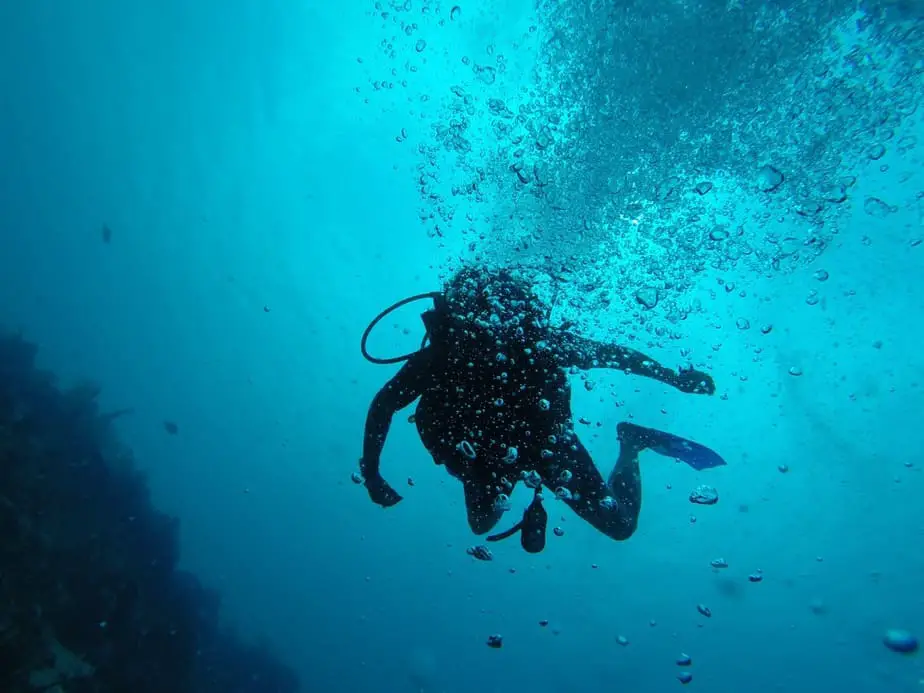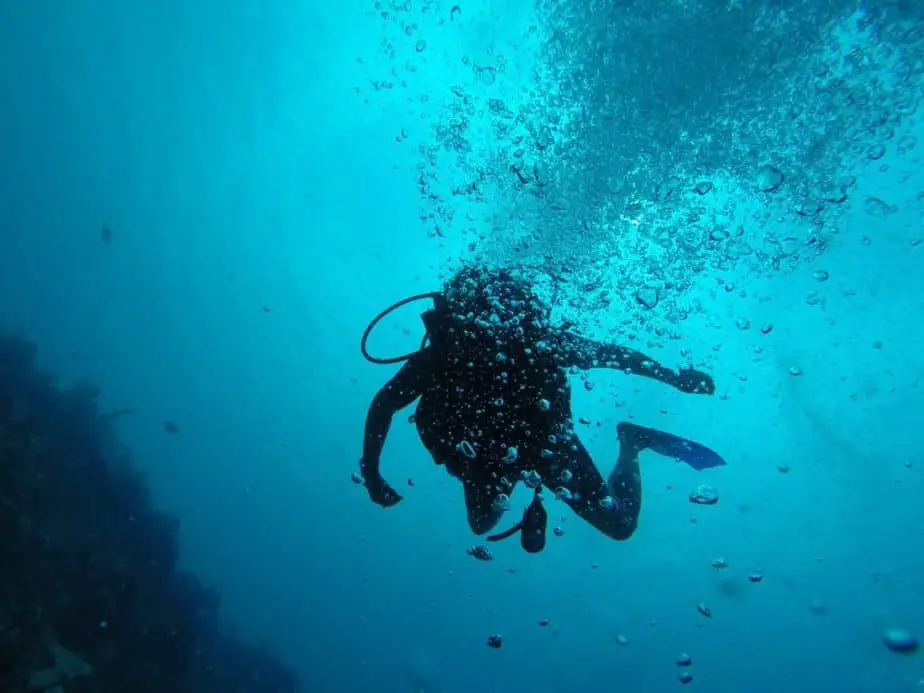The Suunto D5 is a powerful recreational dive computer from the Suunto D-series line of products. Despite being numbered lower than the D6i, the D5 actually came out several years after the D6i and is much more advanced.
With this release comes a whole new suite of features. Of particular note is Suunto’s new Fused™ 2 RGBM decompression algorithm. On top of that, the D5 features a sleek design and is packed full of features and innovations that divers will be sure to love.
The D5 seems to be Suunto’s answer to the smartwatch and dive computer hybrid devices that have been rising in popularity, most notably the Shearwater Teric and Garmin Descent MK1. In addition to being packed with high end features, it would seem versatility is beginning to play a large role in the success of a product nowadays.
With that said, Suunto isn’t the world’s largest manufacturer of dive computers for nothing. In fact, they were the ones that started the watch-style dive computer trend in the 80s starting with the Stinger, so they are no strangers to innovation. We are excited to see how their umpteen years of experience manufacturing dive computers is reflected in the D5’s specifications and functions. Let’s see if it is worth the hype and your money.
Suunto D5 First Impressions
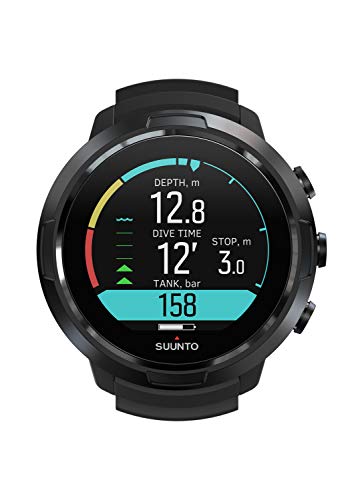
Suunto is finally joining the latest trend of making stylish dive computers with smartwatch functionality that can be used both in and out of diving. In fact, the D5 marks many firsts for Suunto. It is also their first dive computer with a user-rechargeable battery as well as a new decompression algorithm.
On top of that, we were pleasantly surprised to see the price tag is actually affordable for what the D5 offers. This alone will surely make it a popular option for recreational divers of all levels, though beginners could probably start with a more basic model.
At first glance, what stood out to us was the D5’s sleek design. Since the D5 is also intended to be worn as a wristwatch, it bears a striking resemblance to modern smartwatches than the bulky, rectangular dive computers of old.
The full-color screen with numerous display options paired with changeable straps gives you ample possibilities to look stylish. The D5 looks just as likely to be worn at the office as on a dive boat. Don’t take our word for it; the D5 even won an award for its beautiful design.
We like the style of combining smart technology and functionality with a streamlined design. The D5’s frame isn’t the only thing that’s shiny; within is a host of shiny new features like mobile notifications, wireless mobile connection, wireless tank pressure, a digital compass, numerous haptic (vibrating) alarms, and much more.
Appearance and Display
As you are no doubt starting to get tired of hearing us gush about how beautifully designed and sleek the D5 is, let’s talk about it more objectively. First, it’d be a shame if this nice looking watch took a few bumps or got scratched. Weighing only 90g with a 53mm watch face, it is on the small side, which is why we were relieved to find out how durable it is despite appearances.
Its frame is made from reinforced composite with a stainless steel bezel, and at the front of it all is a mineral crystal display. Clad in all of this armor, the D5 is ready to do battle with the elements and withstand the occasional bump and drop.
Next, its full-color, backlit LED screen is vibrant and easy to read from even while underwater or under direct sunlight. You can adjust the way the information is displayed for each dive mode. Not all of the information it is monitoring can be displayed on one screen, so toggling is necessary to access the less pertinent information such as water temperature. You can navigate the menus easily with the three large buttons located on its right side.
Furthermore, the D5 is available in black or silver with numerous color strap options. Not only can you color-match with the rest of your scuba equipment, but you can also consider how the straps match with your everyday clothes or in the situations you plan on wearing it to. Changing the straps is convenient with the quick-release system to help you change the look of your Suunto D5.
For divers that wear thick wetsuits, longer straps are available. For those casual, laidback days you can switch to lifestyle straps, such as leather, to fit whatever occasion is coming up.
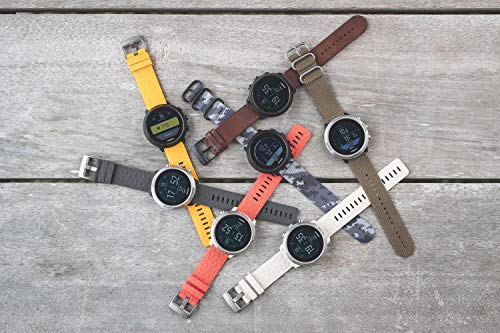
Diving Functionality Overview
The D5 has a maximum operating depth of 100m (328ft) and should only be used in water temperatures between 0°C – 40°C. For the vast majority of recreational divers, these ranges are sufficient for their activities. Aside from its standard dive mode, the D5 also has Air/Nitrox, Freediving, and Gauge modes.
In Nitrox mode, you can switch between three Nitrox mixes and also track each one with up to three Suunto Tank PODs (wireless air transmitters). Thanks to air integration support, you can track your gas pressure, air consumption rate, and time remaining for each tank.
Track and review your last 200 dive hours (or 400 dives) with the logbook functionality. You can even bookmark your favorite dives so it is easier to find it in the future. The amount of data that the D5 monitors is awesome, particularly if you have the Tank PODs installed. For instance, with location settings, you can even record the exact location of your past dives on a world map.
There is a dive planning mode included in the D5. We feel it is on the simplistic side, however it should be enough for planning recreational dives.
Decompression Algorithm
Suunto has finally switched from its usual, notoriously conservative algorithm, to their more adaptable and accurate model, the Fused™ 2 RGBM decompression model, henceforth referred to as the RGBM 2 algorithm. The RGBM 2 is a combination of the best elements of the Suunto Technical RGBM and the full RGBM algorithms.
Even though it is a new algorithm, divers who have used Suunto computers in the past will be familiar with some standard features: NDL time penalties for continuous multi-day diving, dives where the surface interval time was insufficient, rapid ascents, and dives deeper than the previous one (reverse profiles).
If the penalties aren’t enough to persuade you to dive with more restraint, the D5 can go even further. Should you break a decompression ceiling for more than three minutes, the D5 will lock you out and stop displaying any decompression information.
“Wait a minute, penalties? I thought this algorithm was more liberal!’ you might be asking. Indeed, it is, but that doesn’t mean that the algorithm throws caution into the wind. With that said, the RGBM 2 is designed to allow for overall longer bottom times and minimize ascent times as long as you follow its recommendations so as not to trigger any time penalties.
While recreational divers probably won’t have any issues following the instructions, technical divers may deviate and get hit with time penalties or a lockout. As such, it is a good idea for tech divers to have two dive computers just in case.
We also would like to take this time to remind readers that the D5 is a recreational computer, even though Suunto claims it is suited for CCR and technical diving. Furthermore, the no-fly times on the D5 are shorter since the decompression model no longer requires tissues to be completely free of residual gas.
Adjustable Conservatism Settings
We are glad to see that Suunto has taken the customer feedback to heart by giving users the option to make the algorithm more liberal, or even more conservative if they choose to. There are five conservatism levels to select from, ranging from +2 to 0 and then to -2. As you might surmise, the +2 and +1 levels are for making the algorithm more conservative.
On the other hand, the -1 and -2 levels make the algorithm more liberal, which will hopefully reduce the number of jokes about the Suunto algorithm going into deco while in the shower. The standard conservatism level is 0, and we generally recommend leaving it there or making it more conservative if you are a beginner. Only increase the aggressiveness if you know what you are doing.
We appreciate Suunto giving users the option to adjust the algorithm in either direction. Typically, Suunto dive computers would only allow for an increase in conservatism levels, so to see more liberal options open up is nice.
Deep Stop
In previous Suunto dive computers, deep stops were voluntary. For the D5, the default setting is that deep stops are recommended for any dive deeper than 20m (65ft), unless the setting is turned off. If this step is optional, then why do it, you ask?
One, it is really not that much of an inconvenience, and two, deep stops may provide benefits that help avoid decompression sickness. However, not everyone agrees, so at the end of the day, Suunto has given the option to turn this feature off.
Ascent Rate
Many dive computers will remind you to keep your ascent rate under 10m or 32ft per minute. The reason why this number is so prevalent is due to the findings from studies conducted by the Divers Alert Network (DAN) which report that 9.1m or 30ft per minute is the ideal ascent rate when diving recreationally.
Don’t worry if you accidentally go over. The D5 has safeguards in place so that you can continue to ascend safely even if there are a few hiccups along the way. For instance, you may speed up if there are reefs or debris in your way. When this happens, the D5 will provide an alert reminding you to make a brief stop. A countdown will display how long your stop should be before you can continue ascending.
Connectivity
USB cables are a thing of the past; with the wireless Bluetooth connectivity of the Suunto D5, you can easily transfer your dive log, update your firmware, change the device’s settings, and even share pictures and videos of your dive through social media sharing.
The convenience that wireless connectivity affords you is immense. To start, you do not have to worry about your dive computer running out of memory; just back-up the data to your smartphone via Bluetooth. Second, you probably won’t bring your laptop with you on your trip, but you will always have your smartphone, so that is one less item you don’t need to bring with you.
Bluetooth makes staying up-to-date with the latest firmware upgrades the new normal. Updates are provided regularly free of charge, so you can have the latest features and bug fixes to make your dive that much safer.
Furthermore, not only does the Suunto D5 look like a smartwatch, it literally is one due to its Bluetooth connectivity. The D5 can pair with your smartphone to receive various phone notifications.
Similarly, the D5 can easily connect to the Suunto Tank PODs (wireless tank pressure transmitters). After screwing the transmitter into the first stage regulator and pressurizing the system, hold the D5 close to the transmitter and it will automatically detect it and pair up.
Lastly, you still have the option to use a USB cable to connect the D5 to a computer if you prefer to analyze your dive data using Suunto’s desktop app instead.
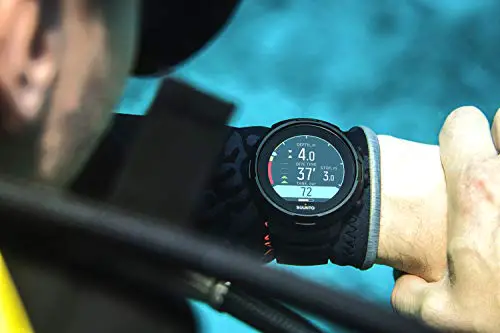
Alarms
What good is a dive computer that doesn’t provide crucial safety warnings? Thankfully, the D5 has a wide range of notifications and alarms to keep you updated on your safety stops, no-fly times, deep-stops, and so on.
On the other side of the coin, a dive computer that just won’t shut up is irritating. That is why Suunto has allowed some of the less crucial sound and haptic notifications to be configured. For instance, you can turn off the automatic deep stop and altitude adjustment warnings.
Some other parameters that can set off an alarm include:
- Exceeding the recommended 10m (32ft) per minute ascent rate.
- High PO2 greater than 1.6 bar.
- Deep stop or decompression ceiling violations.
- Gas switching – will alert you if a better mix is available.
We are a fan of the new haptic (vibrating) alarms featured in the D5. Having an alarm that can warn you through another one of your senses increases the chances you will notice it. Sometimes audible alarms can be hard to hear, but a vibration on your wrist will be just as effective on land as it is underwater. It is also a silent way to notify you without scaring off any nearby fish.
Battery
The D5 is the first recreational Suunto dive computer to be powered by a user-rechargeable battery. Just connect your device to a power source using the included USB cable to charge it. Once fully charged, you can use it for 6 to 12 diving hours, depending on the kind of diving you are doing and what features you have turned on. If you are just using the D5 to check the time in watch mode, then it will last substantially longer.
We appreciate this change to the battery because it means you don’t have to deal with all of the annoyances of changing the battery. Whether you are changing it yourself and having to deal with O-rings and tiny screwdrivers, or shipping to a service center, these are all things of the past with the D5.
One major downside of this feature is that you need to recalibrate the compass each time you recharge the battery. For those who don’t use the compass, this is not much of an issue. However the built-in compass is a major feature for some, and having to deal with recalibration each time can get annoying.
Idle and Sleep Modes
Without the idle and sleep modes to conserve battery life, the D5’s relatively short battery life would be even shorter. The idle mode will put the D5 in a low-power state after two minutes of inactivity. Simply press any button to “wake” the device up.
The deep sleep mode is automatically turned on if the D5 has not received any inputs for a day or more. Once again, you can activate it by pressing any button, connecting it to a computer, or submerging it underwater.
Since the D5 includes a full-color display, it requires more battery power to operate. The idle and sleep mode is intended to keep the D5 running as long as possible so that it won’t suddenly die during a long day spent diving or, God forbid, in the middle of a dive.
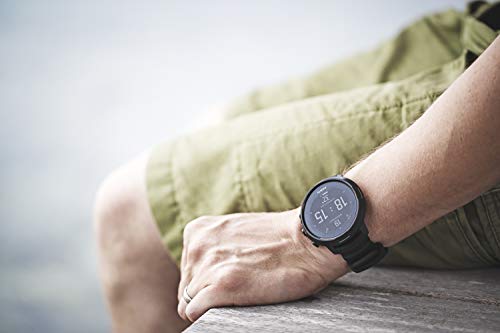
Suunto D5 Alternatives
Where dive computers were few and far between at one point, nowadays they flood the market. Ranging from cheap, newbie-friendly options such as the Cressi Leonardo, to top-of-the-line, expensive but powerful technical diving computers like the Shearwater Perdix AI, there is a wide range of computers to choose from.
The D5 falls somewhere on the higher end of the spectrum, but it is not quite top-of-the-line. Also considering the versatile smartwatch functionality of the D5, and there are few competitors in this area of the market that can compete, namely the Garmin Descent MK1 and Shearwater Research Teric. We also give an honorable mention to the Vyper Novo for those of you who don’t particularly care about the smartwatch functionality. Let’s take a look at what each has to offer.
Garmin Descent MK1
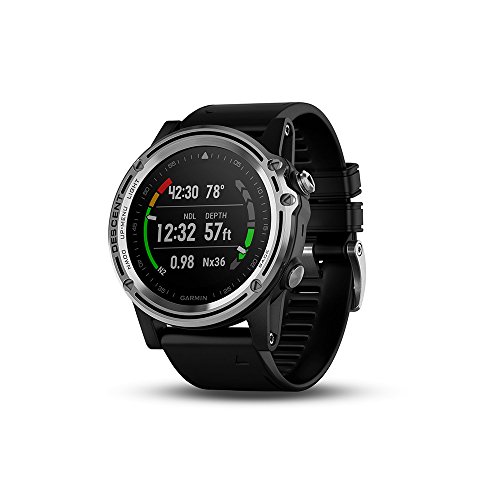
If you lead an active lifestyle and participate in a variety of outdoor activities, then you need the Garmin Descent MK1. The “gimmick” of the Descent MK1, if you can call it that, is that it is a watch that can be used in nearly any environment. As of writing this review, it is so far the only dive computer that is a combination of a dive watch, smartwatch, and fitness tracker.
The Descent MK1’s strength is also its greatest weakness. It does many things well, but Garmin is primarily known for their fitness trackers, and the Descent MK1 is their first ever dive computer. As such, the newly added diving functionality is solid, but cannot compare with the likes of established dive computer manufacturers like Suunto or Shearwater.
With that said, the Descent MK1 is very much a watch for active individuals. If you do many other outdoor activities in addition to diving, the MK1 can keep up with you and provide valuable data all the while. It has your standard smartwatch functionality as well as a heart rate monitor which, as far as we can tell, is currently the only dive computer that offers this.
If we were comparing the Descent MK1 to the D5 purely in terms of diving features, however, then the D5 comes out ahead. One area where the D5 has the clear advantage is its support of air integration, whereas this feature is suspiciously absent in the Descent MK1. However, the MK1 does have features for recreational diving purposes such as gas-switching, GPS and compass navigation, a large logbook memory, and many customizable alarms.
Overall, the Garmin Descent MK1 is a jack-of-all-trades. It provides many features for an active lifestyle and is quite competent in all areas. If you want a great all-rounder dive computer, then the Descent MK1 is a fantastic choice. If you care only about diving and require air integration support, then look elsewhere.
Check out our full review of the Garmin Descent MK1 here.
Shearwater Teric
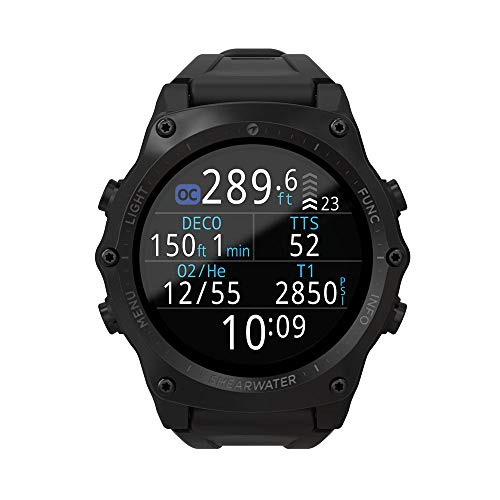
The Shearwater Teric is Canadian tech diving giant Shearwater’s first foray into the watch-sized dive computer market. It utilizes similar technology as the purely technical diving focused Shearwater Perdix, however the Teric is designed with the recreational diving market in mind.
First, a note on the price. The Teric is extremely expensive, with a base price of around $1,000 without transmitters. That is nearly double the price of the Suunto D5. And yet, the price is justified because of the edge it has on both the Descent MK1 and D5.
To start, it has more advanced functionality such as support for rebreather and Trimix diving, as well as a significantly deeper maximum operating depth of 200m (656ft). As such, you can truly consider the Teric to be a top-of-the-line, technical diving watch. What’s amazing is that all of this is packed into a watch-sized frame.
The Teric has a more rugged design akin to a sports watch, and like the dive computers mentioned in this review, it can be worn as a daily wristwatch. If you want the best of both worlds and money is no expense, then you should consider getting the Shearwater Teric.
Read our full review of the Shearwater Research Teric here.
Suunto Vyper Novo
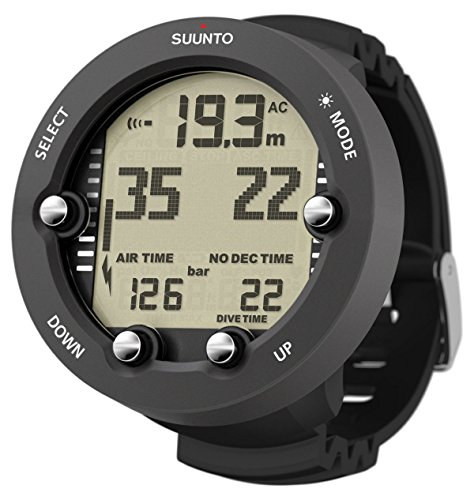
The Vyper Novo is a fellow air integrated dive computer from Suunto that is also a top contender. It is difficult to choose between these two devices, and we suspect that the deciding factor will be cost. The Vyper Novo has comparable diving functionality and packs lots of features into its big frame.
Due to the Vyper Novo’s large size, despite looking watch-like, it cannot really be used as a watch outside of diving. The D5 is slimmer and has numerous smartwatch capabilities, making it more versatile (and expensive).
Both dive computers from Suunto feature gas-switching, and are EANx compatible up to 99%, both have a built-in 3D compass, and of course, both support optional wireless air integration.
There are a few notable differences with these devices as well. First, the D5 marks Suunto’s first time making a dive computer with a rechargeable battery. The Vyper Novo has a user-replaceable battery that lasts longer. Next, the D5 runs Suunto’s latest algorithm, the Fused™ 2 RGBM, whereas the Vyper Novo runs the standard RGBM algorithm.
Furthermore, the D5 has a deeper maximum operating depth of 100m (328ft) to the Vyper Novo’s 80m (262ft). This is a notable difference indeed, however both devices were designed for recreational diving, and for that purpose it may not matter very much.
Lastly, the D5 has a full-color screen and the Vyper Novo does not. As you will notice, these differences are not that significant except for the differing algorithms. If you do not care for the smartwatch functionality, color LCD, or new algorithm, then the Vyper Novo is the cheaper option that will suit your needs.
Read our full review of the Suunto Vyper Novo here.
Frequently Asked Questions
Which is better: the Suunto D6i or the D5?
If you were to think about it logically, shouldn’t something named the “D6” come after the D5? And yet, the Suunto D6i/D6i Novo as well as D4i/D4i Novo came out roughly around the same time many years ago and they bear a striking resemblance to each other. The D5 is actually the newest of the bunch, and is a departure from their design in many ways with its new algorithm and rechargeable battery. If you have the budget for it, we recommend the D5.
Companies are often trying to impress their customers with their unique naming conventions but all it results in is confusion. If you are looking for the next release after the D5, it would be… *drum roll please*… the Suunto 7. With the 7, Suunto has made a watch that can be used as a fitness tracker and smartwatch, but is not designed for scuba diving despite being waterproof. We think you should just get a Garmin Descent MK1 instead.
How do I pair my Suunto D5 with a smartphone or computer?
In order to connect your devices, you must first install the app from your smartphone or computer. Second, make sure Bluetooth is turned on on your smartphone, and that you have a USB cable if you prefer to connect to the computer. Afterwards, it is simply a matter of the devices detecting each other in the app via your preferred connection method.
How do I take care of the Suunto D5?
Keeping your D5 running in tip-top shape is straightforward; simply rinse in fresh water after a dive and fully dry it before storing it just as you would any other scuba diving equipment. If you change straps between diving and everyday use, remember to switch back to silicon straps before diving. Lastly, Suunto recommends you send the device in for calibration and pressure testing after every two years or 500 dives.
What We Didn’t Like About the Suunto D5
We have a couple of complaints about the Suunto D5, one is minor and one is potentially a deal-breaker for some.
Let’s start with the minor issue. By designing the D5 to use a rechargeable battery, Suunto has fixed one issue by removing the need to send the dive computer in for battery replacements every year. However, they have introduced another in the form of a compass that needs to be recalibrated after each recharge. Also, the battery life lasts only 6-12 hours depending on how it is used.
The second – and this is the more pressing issue for some – is its lockout “feature”. If you break a decompression ceiling for more than three minutes, you will get locked out of the device. In other words, the algorithm stops calculating your decompression information. This is to discourage you from further diving because the computer detects that you might be being irresponsible and putting yourself at risk.
Suunto has always been known for making extremely conservative dive computers and this is them trying to ensure your safety to your chagrin. We can see where they are coming from. After all, the D5 is designed to be a recreational dive computer, not a technical one, and divers with less experience may need an unforgettable lesson on the importance of following deco instructions.
However, there are some situations where the lockout can occur accidentally. For instance, if a tech diver were to keep the D5 around as a second dive computer and the dive plan on their main device deviated from the D5, then the D5 will always end up being locked out.
Technical Specifications and Features
- Can be worn as both a dive watch and a smartwatch.
- Intuitive, beginner-friendly menu navigation.
- Switch between metric and imperial display.
- Black or silver stainless steel bezel with numerous color strap options.
- Three dive modes: Air/Nitrox, Freedive and Gauge Mode.
- Nitrox compatible up to 99% O2 with ppO2 between 1.4 and 1.6 bar with gas switching.
- Maximum operating depth of 100m (328ft).
- USB included.
- Vibrant color LED display.
- Adjustable conservatism settings (from P+2 to 0 to P-2, + being more conservative, – being more liberal, and 0 being the default).
- Altitude settings.
- Logbook functions.
- Rechargeable battery.
- Support for optional wireless air integration.
- Watch functions.
- Built-in 3D digital compass.
- Color-coded haptic (vibrating) alarms.
- Each dive mode display can be customized to your liking.
Suunto D5 Review: The Verdict

All in all, the Suunto D5 is pretty much the perfect dive computer for recreational diving. It is filled with great functionality such as gas switching, multiple dive modes, a new algorithm, a rechargeable battery, built-in 3D compass, and air integration support. It manages to pack all of this into a sleek, stylish frame that wouldn’t look out of place in a bar or any other casual event. To top it off, it is durable and can last you for many recreational diving adventures.

